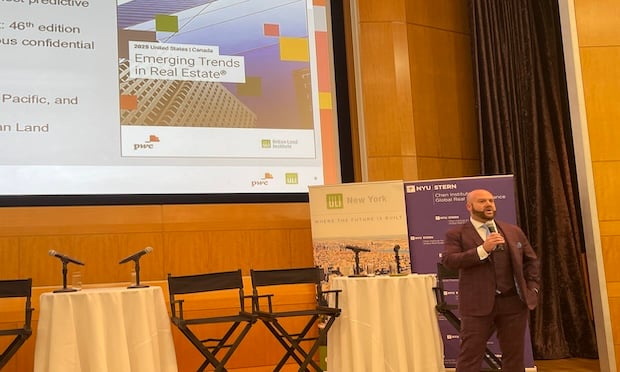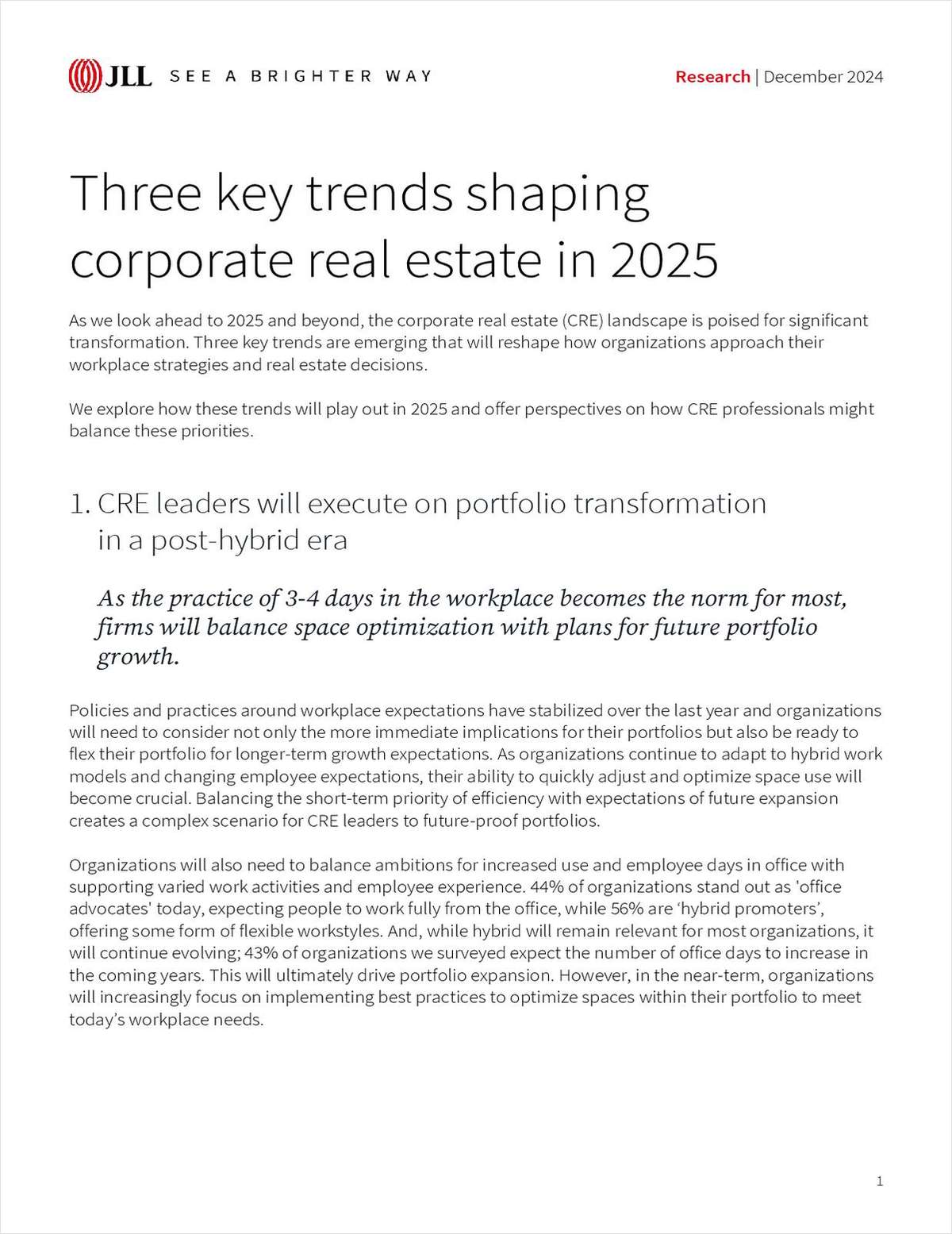 CHICAGO— JLL has been in the midst of a high-tech transformation, and it has done so both through strategic acquisitions and developing the techniques in-house. But in the seven or eight years that has passed since launching this initiative, the Chicago-based company has succeeded in bringing new sets of analytic tools to every aspect of its business. And so far, the effort has been quite worthwhile. Doug Sharp , president of JLL Corporate Solutions, tells GlobeSt.com that the company has already provided about $500 million in services to its clients through these high-tech efforts. Perhaps its best known tech endeavor is the RED data and analytics platform launched in 2015, which gives real estate managers access to granular-level data about maintenance, equipment use and building performance in an easily-digestible manner. But RED does more than assist with property management issues. Users can also glean information about the macroeconomic environment, and get help with project management and lease administration. “Our strategy goes across all service areas,” Sharp says. He points out that JLL's latest tech-related acquisition, that of BRG , a Dallas-based expert in workplace technology, bolsters RED by helping corporate real estate executives integrate off-the-shelf management systems including ARCHIBUS, Manhattan, CenterStone, IBM TRIRIGA and iOffice software. This greatly simplifies CRE executives' efforts to not only manage facilities and administer leases, but to also oversee moves, and add or change projects. “If we can make a 5% impact on a portfolio, that can mean millions and millions in savings,” says Sharp. But JLL has also sought to increase the analytic power of its facilities management offerings. In late 2015, it acquired Corrigo Inc. , a Silicon Valley pioneer in cloud-based facility management. This purchase helps JLL do more than provide clients with so-called “smart buildings,” which have become more common in the past few years. Other platforms, for example, can record when an air conditioner gets repaired, what was done and by which vendor, Corrigo can also provide GPS data showing how long the repairman stood in front of that air conditioner. And by combining that data point with many other similar bits of data from a broad range of properties, Corrigo can tell a client whether the vendor was performing efficiently. And to help clients with what Sharp calls the third slice of the commercial real estate pie, along with portfolio and facilities management, JLL also has a tech-based capital planning tool which rationalizes that process. Such planning is usually “an extreme pain for most companies,” and for many capital just “flows to the squeaky wheel, the one who complains the most.” JLL does not approach these issues in a haphazard manner, Sharp adds. The company has an innovation team of roughly a dozen people that sifts through and vets many ideas. They decide if clients could use a new service that utilizes technology, and then research whether it would be best for JLL to provide it by acquiring a firm such as Corrigo, or developing the service in-house. The innovation team also has access to a virtual community of experts that represent every aspect of the business, including property management, lease administration and capital planning. Every month, about 30 people take part in these vetting meetings. “It's an Americas team,” says Sharp, and “it goes across our entire business.”
CHICAGO— JLL has been in the midst of a high-tech transformation, and it has done so both through strategic acquisitions and developing the techniques in-house. But in the seven or eight years that has passed since launching this initiative, the Chicago-based company has succeeded in bringing new sets of analytic tools to every aspect of its business. And so far, the effort has been quite worthwhile. Doug Sharp , president of JLL Corporate Solutions, tells GlobeSt.com that the company has already provided about $500 million in services to its clients through these high-tech efforts. Perhaps its best known tech endeavor is the RED data and analytics platform launched in 2015, which gives real estate managers access to granular-level data about maintenance, equipment use and building performance in an easily-digestible manner. But RED does more than assist with property management issues. Users can also glean information about the macroeconomic environment, and get help with project management and lease administration. “Our strategy goes across all service areas,” Sharp says. He points out that JLL's latest tech-related acquisition, that of BRG , a Dallas-based expert in workplace technology, bolsters RED by helping corporate real estate executives integrate off-the-shelf management systems including ARCHIBUS, Manhattan, CenterStone, IBM TRIRIGA and iOffice software. This greatly simplifies CRE executives' efforts to not only manage facilities and administer leases, but to also oversee moves, and add or change projects. “If we can make a 5% impact on a portfolio, that can mean millions and millions in savings,” says Sharp. But JLL has also sought to increase the analytic power of its facilities management offerings. In late 2015, it acquired Corrigo Inc. , a Silicon Valley pioneer in cloud-based facility management. This purchase helps JLL do more than provide clients with so-called “smart buildings,” which have become more common in the past few years. Other platforms, for example, can record when an air conditioner gets repaired, what was done and by which vendor, Corrigo can also provide GPS data showing how long the repairman stood in front of that air conditioner. And by combining that data point with many other similar bits of data from a broad range of properties, Corrigo can tell a client whether the vendor was performing efficiently. And to help clients with what Sharp calls the third slice of the commercial real estate pie, along with portfolio and facilities management, JLL also has a tech-based capital planning tool which rationalizes that process. Such planning is usually “an extreme pain for most companies,” and for many capital just “flows to the squeaky wheel, the one who complains the most.” JLL does not approach these issues in a haphazard manner, Sharp adds. The company has an innovation team of roughly a dozen people that sifts through and vets many ideas. They decide if clients could use a new service that utilizes technology, and then research whether it would be best for JLL to provide it by acquiring a firm such as Corrigo, or developing the service in-house. The innovation team also has access to a virtual community of experts that represent every aspect of the business, including property management, lease administration and capital planning. Every month, about 30 people take part in these vetting meetings. “It's an Americas team,” says Sharp, and “it goes across our entire business.”  CHICAGO— JLL has been in the midst of a high-tech transformation, and it has done so both through strategic acquisitions and developing the techniques in-house. But in the seven or eight years that has passed since launching this initiative, the Chicago-based company has succeeded in bringing new sets of analytic tools to every aspect of its business. And so far, the effort has been quite worthwhile. Doug Sharp , president of JLL Corporate Solutions, tells GlobeSt.com that the company has already provided about $500 million in services to its clients through these high-tech efforts. Perhaps its best known tech endeavor is the RED data and analytics platform launched in 2015, which gives real estate managers access to granular-level data about maintenance, equipment use and building performance in an easily-digestible manner. But RED does more than assist with property management issues. Users can also glean information about the macroeconomic environment, and get help with project management and lease administration. “Our strategy goes across all service areas,” Sharp says. He points out that JLL's latest tech-related acquisition, that of BRG , a Dallas-based expert in workplace technology, bolsters RED by helping corporate real estate executives integrate off-the-shelf management systems including ARCHIBUS, Manhattan, CenterStone, IBM TRIRIGA and iOffice software. This greatly simplifies CRE executives' efforts to not only manage facilities and administer leases, but to also oversee moves, and add or change projects. “If we can make a 5% impact on a portfolio, that can mean millions and millions in savings,” says Sharp. But JLL has also sought to increase the analytic power of its facilities management offerings. In late 2015, it acquired Corrigo Inc. , a Silicon Valley pioneer in cloud-based facility management. This purchase helps JLL do more than provide clients with so-called “smart buildings,” which have become more common in the past few years. Other platforms, for example, can record when an air conditioner gets repaired, what was done and by which vendor, Corrigo can also provide GPS data showing how long the repairman stood in front of that air conditioner. And by combining that data point with many other similar bits of data from a broad range of properties, Corrigo can tell a client whether the vendor was performing efficiently. And to help clients with what Sharp calls the third slice of the commercial real estate pie, along with portfolio and facilities management, JLL also has a tech-based capital planning tool which rationalizes that process. Such planning is usually “an extreme pain for most companies,” and for many capital just “flows to the squeaky wheel, the one who complains the most.” JLL does not approach these issues in a haphazard manner, Sharp adds. The company has an innovation team of roughly a dozen people that sifts through and vets many ideas. They decide if clients could use a new service that utilizes technology, and then research whether it would be best for JLL to provide it by acquiring a firm such as Corrigo, or developing the service in-house. The innovation team also has access to a virtual community of experts that represent every aspect of the business, including property management, lease administration and capital planning. Every month, about 30 people take part in these vetting meetings. “It's an Americas team,” says Sharp, and “it goes across our entire business.”
CHICAGO— JLL has been in the midst of a high-tech transformation, and it has done so both through strategic acquisitions and developing the techniques in-house. But in the seven or eight years that has passed since launching this initiative, the Chicago-based company has succeeded in bringing new sets of analytic tools to every aspect of its business. And so far, the effort has been quite worthwhile. Doug Sharp , president of JLL Corporate Solutions, tells GlobeSt.com that the company has already provided about $500 million in services to its clients through these high-tech efforts. Perhaps its best known tech endeavor is the RED data and analytics platform launched in 2015, which gives real estate managers access to granular-level data about maintenance, equipment use and building performance in an easily-digestible manner. But RED does more than assist with property management issues. Users can also glean information about the macroeconomic environment, and get help with project management and lease administration. “Our strategy goes across all service areas,” Sharp says. He points out that JLL's latest tech-related acquisition, that of BRG , a Dallas-based expert in workplace technology, bolsters RED by helping corporate real estate executives integrate off-the-shelf management systems including ARCHIBUS, Manhattan, CenterStone, IBM TRIRIGA and iOffice software. This greatly simplifies CRE executives' efforts to not only manage facilities and administer leases, but to also oversee moves, and add or change projects. “If we can make a 5% impact on a portfolio, that can mean millions and millions in savings,” says Sharp. But JLL has also sought to increase the analytic power of its facilities management offerings. In late 2015, it acquired Corrigo Inc. , a Silicon Valley pioneer in cloud-based facility management. This purchase helps JLL do more than provide clients with so-called “smart buildings,” which have become more common in the past few years. Other platforms, for example, can record when an air conditioner gets repaired, what was done and by which vendor, Corrigo can also provide GPS data showing how long the repairman stood in front of that air conditioner. And by combining that data point with many other similar bits of data from a broad range of properties, Corrigo can tell a client whether the vendor was performing efficiently. And to help clients with what Sharp calls the third slice of the commercial real estate pie, along with portfolio and facilities management, JLL also has a tech-based capital planning tool which rationalizes that process. Such planning is usually “an extreme pain for most companies,” and for many capital just “flows to the squeaky wheel, the one who complains the most.” JLL does not approach these issues in a haphazard manner, Sharp adds. The company has an innovation team of roughly a dozen people that sifts through and vets many ideas. They decide if clients could use a new service that utilizes technology, and then research whether it would be best for JLL to provide it by acquiring a firm such as Corrigo, or developing the service in-house. The innovation team also has access to a virtual community of experts that represent every aspect of the business, including property management, lease administration and capital planning. Every month, about 30 people take part in these vetting meetings. “It's an Americas team,” says Sharp, and “it goes across our entire business.”Want to continue reading?
Become a Free ALM Digital Reader.
Once you are an ALM Digital Member, you’ll receive:
- Breaking commercial real estate news and analysis, on-site and via our newsletters and custom alerts
- Educational webcasts, white papers, and ebooks from industry thought leaders
- Critical coverage of the property casualty insurance and financial advisory markets on our other ALM sites, PropertyCasualty360 and ThinkAdvisor
Already have an account? Sign In Now
*May exclude premium content© 2025 ALM Global, LLC, All Rights Reserved. Request academic re-use from www.copyright.com. All other uses, submit a request to [email protected]. For more information visit Asset & Logo Licensing.








